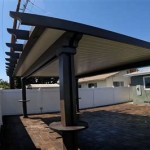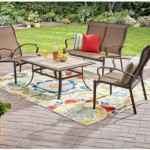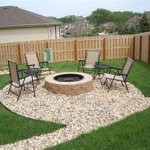Elevating Your Poolside Experience: Outdoor Patio Ideas Around the Pool
An outdoor patio surrounding a swimming pool is more than just an extension of the home; it is a dedicated space for relaxation, recreation, and entertainment. Careful planning and thoughtful design are crucial to create a cohesive and aesthetically pleasing environment that maximizes the enjoyment of the pool area. This article explores various outdoor patio ideas around a pool, focusing on design elements, material selection, landscaping considerations, and functional enhancements.
Choosing the Right Patio Material
The selection of materials for a pool patio significantly impacts its overall appearance, durability, and safety. Several factors should be considered when making this decision, including climate, budget, maintenance requirements, and personal aesthetic preferences. Common patio materials include concrete, pavers, natural stone, composite decking, and tile, each offering distinct advantages and disadvantages.
Concrete is a versatile and cost-effective option that can be customized with various finishes, such as stamped patterns, exposed aggregate, and colored stains. Its durability and resistance to weathering make it a suitable choice for high-traffic areas. However, concrete can crack over time, particularly in regions with extreme temperature fluctuations. Regular sealing is recommended to maintain its appearance and prolong its lifespan.
Pavers offer a wide range of design possibilities, with options available in various shapes, sizes, colors, and textures. They are typically made from concrete or clay and are known for their durability and ease of installation. Pavers are also relatively easy to repair or replace, as individual units can be removed and replaced without affecting the entire patio surface. The interlocking nature of pavers helps to prevent cracking and shifting.
Natural stone, such as flagstone, slate, travertine, and limestone, provides a luxurious and aesthetically pleasing look. Each type of stone has its unique characteristics, with variations in color, texture, and porosity. Natural stone is durable and weather-resistant; however, it can be more expensive than other materials. Some types of stone may require sealing to prevent staining and water damage. The natural variations in stone add character and a unique appeal to the patio surface.
Composite decking, made from a blend of wood fibers and plastic, is a low-maintenance alternative to traditional wood decking. It is resistant to fading, staining, and insect damage, making it an ideal choice for pool areas where moisture is prevalent. Composite decking is available in a variety of colors and textures, mimicking the look of natural wood. It requires minimal upkeep, typically only needing occasional cleaning with soap and water.
Tile is another option for pool patios, offering a wide range of styles, colors, and patterns. Porcelain tile is a popular choice due to its durability, water resistance, and slip resistance. It is also easy to clean and maintain. However, tile can be more expensive than other materials and requires careful installation to prevent cracking and water damage. Properly installed, tile can create a stunning and durable patio surface.
Designing Functional and Comfortable Spaces
A well-designed pool patio should not only be visually appealing but also functional and comfortable. Consider the various activities that will take place in the area, such as lounging, dining, and entertaining, and design the space accordingly. Zoning the patio into distinct areas can help to maximize its usability and create a more organized and inviting environment.
A dedicated lounging area should be furnished with comfortable seating, such as lounge chairs, sofas, and daybeds. Consider adding cushions and pillows in weather-resistant fabrics to enhance comfort and style. Shade structures, such as pergolas, umbrellas, or awnings, can provide respite from the sun and create a more inviting space for relaxation. Strategic placement of plants and trees can also help to provide shade and enhance the ambiance of the lounging area.
A dining area should be equipped with a table and chairs that are appropriately sized for the number of people who will typically be using the space. Consider adding an outdoor kitchen or grill area to facilitate meal preparation and entertaining. Outdoor kitchens can be equipped with various features, such as a sink, refrigerator, and storage cabinets, providing a convenient and functional space for cooking and serving meals. The integration of a bar area can further enhance the entertainment capabilities of the patio.
For families with children, consider incorporating a play area into the patio design. This could include a sandbox, water table, or other age-appropriate play equipment. Ensure that the play area is located in a safe and supervised area of the patio. Soft surfaces, such as rubber mulch or artificial turf, can help to cushion falls and prevent injuries. Fencing or other barriers can be used to create a defined play area and prevent children from wandering unsupervised near the pool.
Lighting plays a crucial role in creating an inviting and functional pool patio environment, especially during evening hours. Consider incorporating a variety of lighting options, such as string lights, pathway lights, spotlights, and underwater pool lights. String lights can create a festive and whimsical atmosphere, while pathway lights can illuminate walkways and prevent accidents. Spotlights can be used to highlight architectural features or landscaping elements. Underwater pool lights can add a dramatic touch to the pool and enhance its nighttime appeal.
The integration of sound systems can further enhance the ambiance of the pool patio. Consider installing outdoor speakers that are weather-resistant and strategically placed to provide even sound distribution. A variety of music sources can be used, such as a stereo system, streaming services, or personal devices. The selection of music should be appropriate for the occasion and the preferences of the guests.
Landscaping and Enhancements Around the Pool
Landscaping plays a vital role in creating a cohesive and aesthetically pleasing pool patio environment. The selection of plants, trees, and shrubs should be carefully considered, taking into account factors such as climate, soil conditions, and maintenance requirements. Landscaping can be used to provide privacy, shade, and visual interest, enhancing the overall enjoyment of the pool area.
Plants that are tolerant of moisture and humidity are ideal for pool areas. Consider incorporating a variety of flowering plants to add color and fragrance to the patio. Tropical plants, such as palms, hibiscus, and birds of paradise, can create a lush and exotic atmosphere. Drought-tolerant plants, such as succulents and cacti, are a good choice for regions with limited rainfall. Native plants are well-adapted to the local climate and require less maintenance.
Trees can provide shade and privacy, creating a more comfortable and inviting pool patio environment. Deciduous trees can provide shade during the summer months and allow sunlight to penetrate during the winter months. Evergreen trees can provide year-round privacy and wind protection. Consider the mature size and shape of the tree when selecting a location, ensuring that it does not interfere with the pool or other structures.
Water features, such as fountains, waterfalls, and ponds, can add a touch of serenity and tranquility to the pool patio. The sound of flowing water can be soothing and relaxing, creating a more inviting and peaceful atmosphere. Water features can also attract birds and other wildlife, adding to the natural beauty of the area. The selection of a water feature should be based on the size and style of the patio, as well as personal preferences.
Fire features, such as fire pits and fireplaces, can extend the use of the pool patio into the cooler months. They provide warmth and ambiance, creating a cozy and inviting space for socializing and relaxing. Fire pits can be built-in or portable, offering a variety of design options. Fireplaces can be constructed from stone, brick, or concrete, adding a touch of elegance and sophistication to the patio. Safety should be a primary concern when using fire features, ensuring that they are located away from flammable materials and that proper safety precautions are followed.
Storage solutions are essential for keeping the pool patio organized and clutter-free. Consider incorporating storage cabinets, benches with built-in storage, or shelving units to store pool supplies, towels, and other items. Storage solutions should be weather-resistant and durable, ensuring that they can withstand the elements. The placement of storage solutions should be convenient and accessible, allowing for easy access to stored items.
By carefully considering these design elements, material selections, landscaping considerations, and functional enhancements, a pool patio can be transformed into a beautiful, functional, and inviting outdoor living space. A thoughtfully designed patio enhances the enjoyment of the pool and provides a versatile area for relaxation, recreation, and entertaining.

5 Pool Patio Ideas For Your Backyard Oasis Premier Pools Spas

11 Pool Landscaping Ideas Bob Vila

Backyard Pool Pergola Ideas Explore Poolside Including How To Beautify Your Deck With A

Unique Pool Landscaping Ideas Forbes Home

16 Pool Landscaping Ideas That Will Make A Splash

16 Backyard Pool Ideas Visualized Brick Batten

The 16 Best Pool Landscaping Ideas

16 Backyard Pool Ideas Visualized Brick Batten

25 Stylish Pool Deck Decor Ideas İdeas Small Design Backyard Designs

Top 6 Pool Deck Patio Design Ideas Luxury Pools Outdoor Living
See Also








